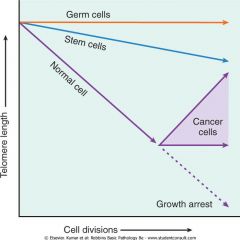![]()
![]()
![]()
Use LEFT and RIGHT arrow keys to navigate between flashcards;
Use UP and DOWN arrow keys to flip the card;
H to show hint;
A reads text to speech;
31 Cards in this Set
- Front
- Back
|
What is neuronopathy?
|
generalized abnormality of the neuron cell body
|
|
|
What is axonopathy?
|
generalized abnormality of the axon
|
|
|
What is axonal degeneration?
|
Primary destruction of the axon with secondary disintegration of its myelin sheath.
may be caused by a focal event or axonopathy |
|
|
What is Wallerian degeneration?
|
type of axonal degeneration
---faster, usually due to nerve being cut -the degeneration of the distal portion of the axon that occurs after a focal injury to the axon. -Shwann cells degrade the myelin and engulf axon fragments. |
|
|
What is segmental demyelination?
|
disruption of the meylin sheath due to death or dysfunction of some of the Schwann cells
grows back irregularly |
|
|
What are some abnormal intracellular accumulations?
|
lipid - steatosis
protein glucose Iron (hemosiderosis and hemochromatosis) Carbon Pigments (lipofuscin, melanin, and exogenous) |
|
|
What are some abnormal tissue accumulations?
|
Calcification - Ca salts
Amyloidosis Proteins (misfolded, not normal) |
|
|
What is Steatosis or Fatty change?
|
Any accumulation of triglycerides in parenchymal cells.
|
|
|
Where does Steatosis occur?
|
most often liver
also in heart, skeletal muscles (usually after denervation), other organs |
|
|
What causes Steatosis?
|
Toxins
Protein malnutrition Diabetes mellitus (common in US) Obesity Alcohol abuse (common in US) Anoxia - very low or total depletion of O2 |
|
|
When you have a bunch of nonfunctional proteins and aggregates grouped together, what are 3 possible outcomes?
|
-Cell Death
-Chaperones - fold and organize the proteins - Ubiquitin and Proteasome pathway - proteins are degrades and sometimes the peptide fragments can be recycled or used in immune pathways. |
|
|
What are Mallory bodies/alchoholic hyalin?
|
Intracellular protein accumulations in liver.
|
|
|
What is Lipofuscin?
|
Brown pigment granules representing lipid-containing residues of lysosomal digestion.
|
|
|
What is hemochromatosis?
|
Hemochromatosis is an inherited blood disorder that causes the body to retain excessive amounts of iron. This iron overload can lead to serious health consequences, most notably cirrhosis of the liver
|
|
|
What is hemosiderosis?
|
a focal or general increase in tissue iron stores without associated tissue damage.
|
|
|
What is calcification?
|
deposition of calcium salts in a matrix or cells
|
|
|
What are physiological and pathological causes of calcification?
|
physiological - growth, repair
pathological - Dystrophic and Metastatic |
|
|
What is Dystrophic Calcification?
|
local deposition in non-viable or dying tissue
---calcification in tuberculosis lung lesion, damaged heart valves, atheromatous plaques, fat necrosis |
|
|
What is Metastatic Calcification?
|
deposition in viable tissue - often widespread
-associated w/ distubance of calcium metabolism (hypercalcemia), like from leukemia ---endocrine disorder ---paraneoplastic syndrom |
|
|
What is an Amyloid?
|
A proteinaceous material deposited in the interstitium
--LM appearance - amorphous eosinophilic --EM - fibrils, non-branching 7.5-10nm wide |
|
|
What is the molecular structure of an Amyloid?
|
beta pleated sheets
|
|
|
What are the 3 most common types of amyloid?
|
AL - light chain
AA A or possibly ATTR (Alzhemer disease) |
|
|
What is the onset of Amyloidosis?
|
begins insidiously (no early signs) and can lead to organ dysfunction - like in kidneys
|
|
|
What is the Pathogenis of amyloidosis that results with AL protein?
|
-production of abnormal amounts of protein
-Unknown (carcinogen?) -Monoclonal B-lymphocye proliferation -plasma cells -Immunoglobulin Light Chains -limited proteolysis -insoluble AL protein |
|
|
What is the Pathogenis of amyloidosis that results with AA protein?
|
-production of abnormal amounts of protein
-Chronic Inflammation -Macrophage activation -Interleukin 1 & 6 -Liver cells - SAA Protein -Limited proteolysis -Insoluble AA Protein |
|
|
What is the Pathogenis of amyloidosis that results with A or ATTR protein?
|
-production of normal amounts of mutant protein
-Mutaion -Mutant transthyretin -Aggregation -Insoluble A or ATTR Protein ---Alzhemer's |
|
|
What can happen in glomerular amyloidosis?
|
Kidneys quit filtering and proteins make it out into the urine
|
|
|
What is pressure atrophy?
|
wasting away of cells/tissue usually due to decreased blood supply
-can occur in any tissue -in permanent tissue, loss is permanent ---benign tumor of meninges causes loss of cerbral cortex |
|
|
How does aging affect cells/tissue?
|
Loss of cells with increased age especially in organs w/ permanent cells
-brain -cardiac muscle -skeletal muscle |
|
|
What are 4 aging theories?
|
-Progressive accumulation of sublethal injury
---decreased oxidative phosphorylation ---decreased protein synthesis ---intracellular accumulations (lipofuscin, AGE) -Multifactoral - Telomere shortening ---In stem and germ cells, telomerases restores length of the telomere ---In adult stem cells, the telomere does become shorter gradually -Clock genes - biological preprogrammed clock -Wear and tear - (especially free radical damage) |
|
|
How do telomere length and telomerase activity compare between germ, stem, normal, and cancer cells
|

|

